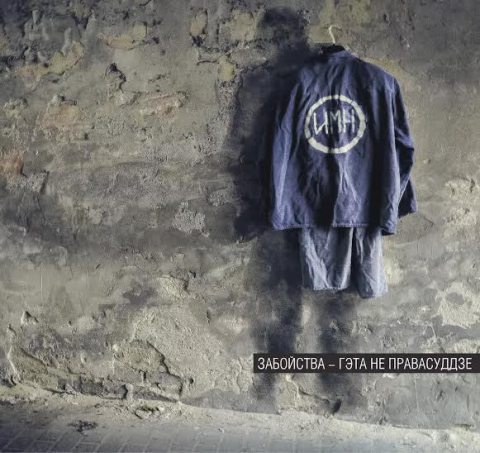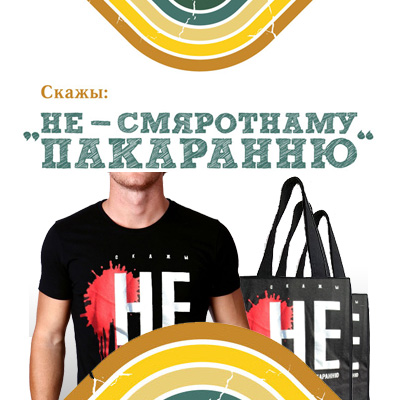Preface by Ales Bialiatski to the book The Death Penalty in Belarus
-

- Aliaksandr Hrunou’s prison clothes. Photo by Viktar Tratsiakou
Life and Death
The Death penalty. These words evoke different feelings and ideas in different people, including fair punishment, cruelty and callousness of the state, the cold steel of the headsman’s axe, civilized barbarism, pistol shots, horror and despair, revolutionary expediency, the guillotine with a basket where the severed heads roll, and many other things. Man has invented thousands of ways to kill his fellows, and his bizarre fantasy with the methods of execution is boundless. People even seem to show more humanness and rationalism in killing animals. After all, animals often kill one another.
A well-known Belarusian artist Lionik Tarasevich grows hundreds of thoroughbred hens and roosters on his farm in the village of Validy in the Białystok district. There are many gamecocks among them. “As soon as they smell blood”, he said, “they peck and maul the one who is wounded. Cocks are more merciless than people”. Is the death penalty a rudiment of man’s animal nature then? Did he also mercilessly kill and maul those who were weaker than him before he started living in caves and wearing animal skins? Recalling the bloody 20th century, in which we were born, I can’t but start questioning the degree of civilization in modern people and the length of the distance between us and our cave ancestors.
The death penalty is a sign of our epoch! It is like a rust that is ingrained so deeply that it cannot be taken out by any acid, or covered by any elite paint. In July 2011 in Norway, Anders Breivik killed 77 people. He threw a challenge to his own people that had abolished the death penalty back in 1902. He, a terrible provocateur, tried to awaken the thirst for revenge in the Norwegians. By his deed he cried, “I kill you and your children, kill me by a court verdict then! Let us see what your human principles go for!” Nevertheless, the Norwegians refused to change their laws for the sake of Breivik. As a result, he was sentenced to 21 years in prison. He is serving his sentence in a three-room apartment, is allowed to receive visitors every week and can use a computer. “What a bitch!”, revolted a Belarusian prisoner, sentenced to 16 years for a murder. “I’d shoot him myself”. “Don’t you think you could be shot for your deeds, too?”, I asked, unable to stand it. “To hell with it!” he answered. “We’d see what you’d say being on the death row,” I thought.
Most Belarusians believe that the death penalty should be kept, with only a small minority that is against it. As a rule, Belarusians don’t like to give clear answers to tough questions. It’s hard for us to choose between “yes” and “no”, and when there is a possibility to hide behind “maybe, yes”, “more no than yes”, and “I haven’t decided so far”, we are happy to do it. But sometimes life doesn’t give us such a choice and it requires an unambiguous answer. Life and death don’t have a grey area or a smooth transition between them. Everyone chooses what colour life and death are on their own, but there is always a great contrast between the two.
The death penalty has divided our society. Well, it isn’t the only stumbling block, but Belarusians aren’t an exception. Let us remember Moses’ Old Testament commandment, “an eye for an eye, a tooth for a tooth”. Yet in the New Testament, is the completely different attitude of Jesus, “If someone strikes you on the right cheek, turn to him the other also.” Perhaps these incompatible biblical commandments are the basis of the human reaction to the death penalty, as it is like revenge. Can love and grace let the man do without it?
In 2011, I had to spend four months in a remand prison on Valadarski Street (“Valadarka”). The old prison cellblock, the so-called Piščalaŭski castle, was falling apart. There were cracks across the walls, and one of the towers had collapsed. In order to keep the building up, it was propped up with iron bars. Prisoners had been relocated elsewhere years before I got there. We were kept in a building that seemed to have been built in 1970s, but were taken for walks by the old tracks.
“Out for a walk!,” the guard would cry. We would walk out in a single file, keeping our arms behind our backs for decency’s sake, and descend from the second floor to the basement. Another guard was standing on the staircase, and he would knock on the edges of the iron banisters with a big key. There was a sign for the guards on the first floor to wait and to not lead the prisoners out, as well as for another guard who would receive us in the basement. This basement was a real vault of the old prison cellblock with a semi-circular ceiling and cells on both sides, and was somewhat wet and gloomy.
The “apartments” in the vaults were no longer inhabited – prison property was kept there. However, on the left, behind an unremarkable door, as Valodzia (who has already spent more than three years in the remand prison due to courts and repeated trials) pointed with a nod of his head, there was a special corridor. Death row prisoners are kept there. We reached the end of the vault, turned to the right and walking through the surviving tower with a spiral staircase overhead, got to congested walking yards. We would go back the same way, but the death row prisoners would remain behind, immured in the ground.
On November 30, 2011, when I was still in Valadarka, two prisoners who were kept in the special corridor, Uladzislau Kavaliou and Dzmitry Kanavalau, were sentenced to death. Three days later I was taken to the remand prison in Žodzina. We were lead out to the transfer through the prison gate (at which Ivan Pulichaŭ, a terrorist, had been hanged a hundred years ago), while Kavaliou and Kanavalau were left in the prison, waiting to be shot.
In March 2012, Kavaliou and Kanavalau were executed by shooting. At that time, I was already in the Babrujsk colony. I was surprised by the unanimity of prisoners who, when it came to this sentence, were saying in one voice, “No, it’s not they who are guilty.” Everyone was convinced that these two were shot so quickly in order to “cover the tracks”, making it so that it would be impossible to find the truth. Nobody believed the information that was given by the investigative committee and the prosecutor’s office. “Who organized the explosion in the subway then?” I asked. “They did”, answered the inmates, pointing their fingers upwards.
In 2013, a sheet of paper with an announcement that a prisoner had been sentenced to death for killing an inmate in Mahilioŭ prison, was hung at the brigade’s newsstand, next to the newspaper “Šviejnik” (“Seamster”). As it was written in the newspapers, it was Ryhor Yuzepchuk. The announcement was, most probably posted, for “educational purposes”. However, what could this sheet do? About fifty people in the brigade were imprisoned for murders, and none of them, even if they wanted, could change everything in their lives and start from an empty page. When I wrote my colleagues about this announcement, it was quickly removed, and a prison officer warned me that my letters would not be let out, especially if I wrote even a word about the prison.
It is impossible for those who have never been in prison to understand what it is. It is even more impossible to understand how it is – to be sentenced to death and be waiting for the execution. A state is enclosed with boundaries, a penal colony – with a fence, a penal cell or a prison – with four walls, whereas the cell of a death row prisoner is the very centre of hopelessness, the very essence of life and death, like the needle, where the soul of the fire-drake hides. If we break the needle – will the fire-drake die?
Files
- 2016-death-penalty-belarus-en.pdf (5.53 Mb)

